How to tune a guitar
, 6 June 2003
Reasons
Tuning a guitar seems easy at first sight: just make sure all six strings have the correct pitch, and you’re done. But it’s not that simple, because several factors complicate the matter. As a result, an acceptable tuning is always a compromise:
- Even temperament.
- Extra string tension when pressing string against fret.
- Overtones are not exact multiples, and need not be.
I’ll explain these factors in more detail later. If you want to know more, click on the hyperlinks in the items above. But there’s no real need to know, if all you’re interested in is to be able to tune a guitar.
Summary of my method
- Tune one string to a base note.
- Tune the other strings to it, using intervals and chords.
- Repeat step 2 until satisfied.
The tuning steps in detail
Tune one string to a base note.
This is usually done with the
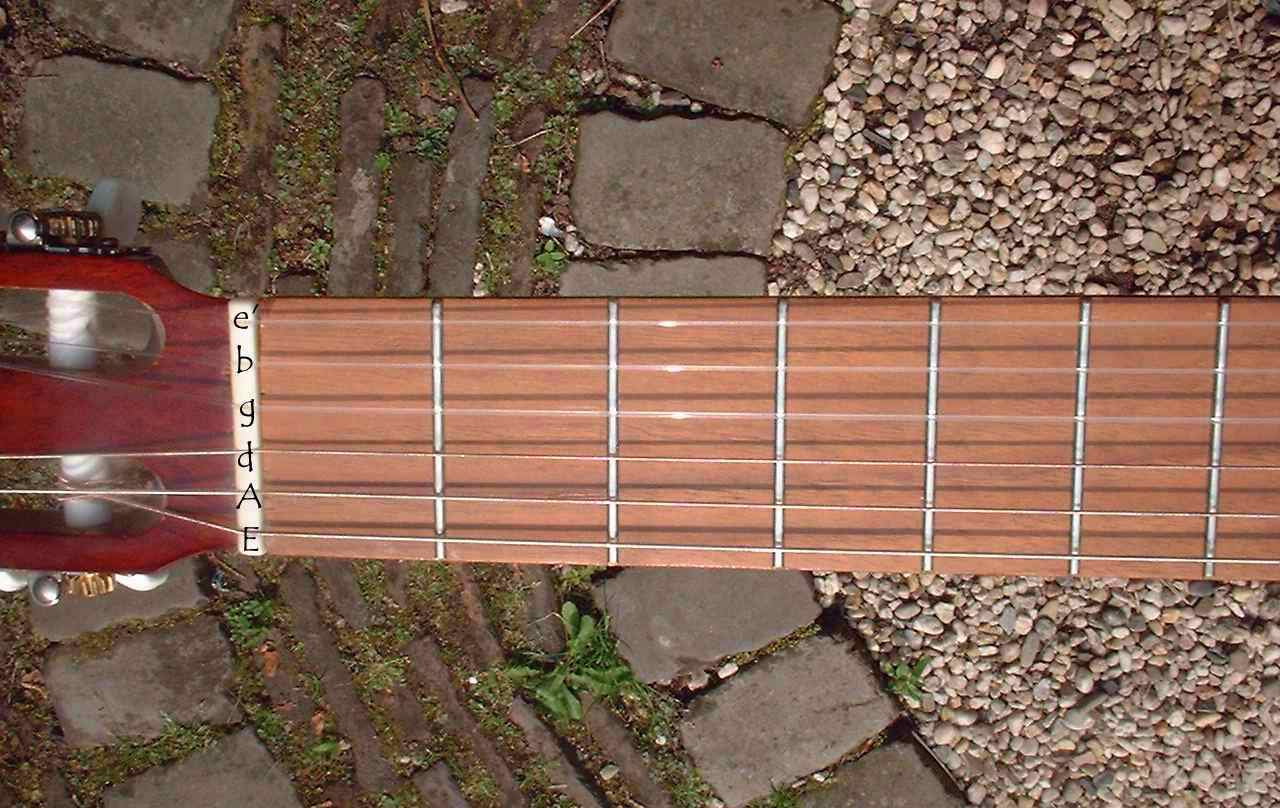 A string
(the one but thickest, one but lowest, one but closest to
your face when looking down while holding the guitar in
playing position)
because most tuning forks
A string
(the one but thickest, one but lowest, one but closest to
your face when looking down while holding the guitar in
playing position)
because most tuning forks
 are tuned to the note A (440 Hz). The string itself is two octaves lower,
at 110 Hz.
are tuned to the note A (440 Hz). The string itself is two octaves lower,
at 110 Hz.
You can also use a well-tuned
piano
 as a reference, or a pitch-pipe, various types of which are
commercially available:
as a reference, or a pitch-pipe, various types of which are
commercially available:


 .
But if you do, use only one pipe for one string, not any of the other pipes.
In other words, you use the pitch-pipe only to tune the guitar’s A string, but not
any of the other strings.
.
But if you do, use only one pipe for one string, not any of the other pipes.
In other words, you use the pitch-pipe only to tune the guitar’s A string, but not
any of the other strings.
Tune the other strings to it, using intervals and chords.
I’m assuming here that the guitar is already close to a correct tuning, and that the strings are not new. Otherwise, perform a rough pre-tuning first.
Now that the A string (A or 5th) is right, tune the d or 4th, e′ or 1th and E or 6th, then also other strings, to match, as follows:
Play the open A string ("open" means = no finger on fretboard) together with the
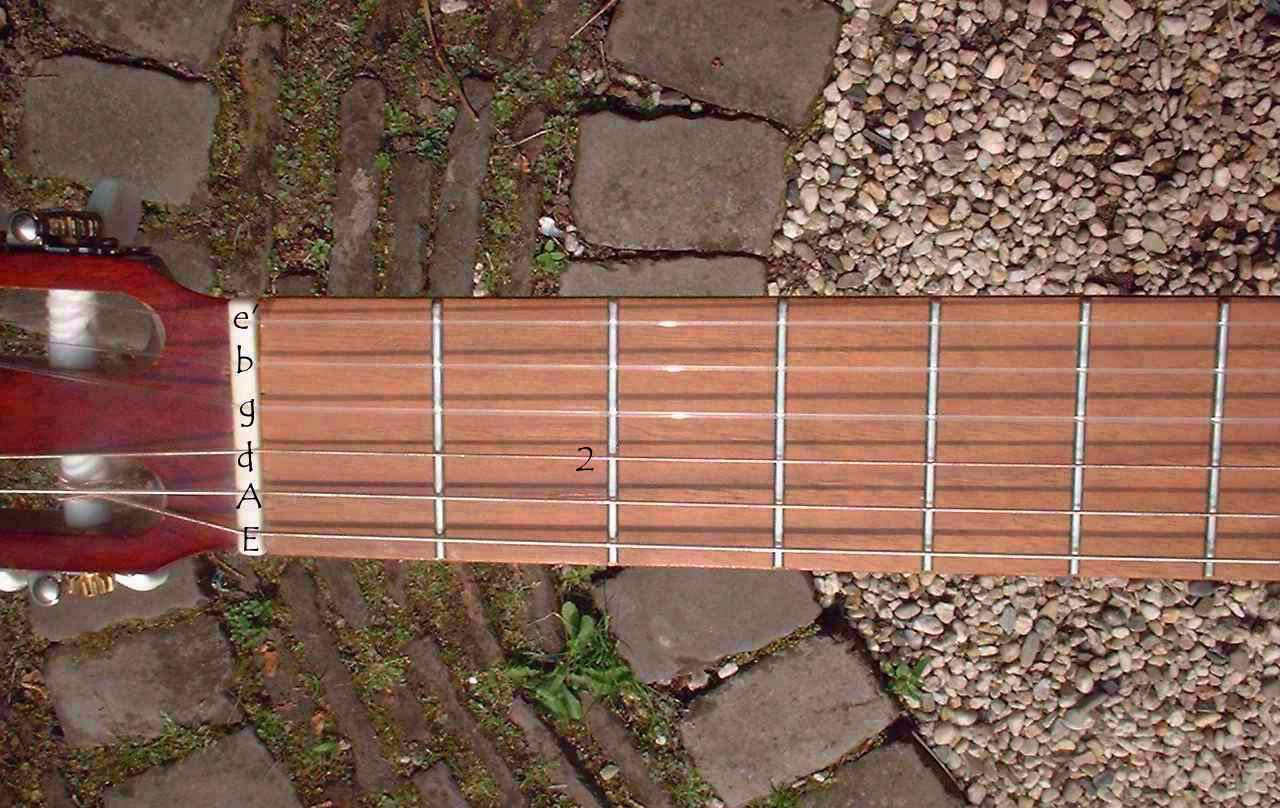 d string,
with a finger pressing it against the second fret.
Adjust the tuning peg for the d string until the two notes sound
well together. "Sound well" means the sounds flow together, into
one another, almost as if they were one, until you hear no "beat".
d string,
with a finger pressing it against the second fret.
Adjust the tuning peg for the d string until the two notes sound
well together. "Sound well" means the sounds flow together, into
one another, almost as if they were one, until you hear no "beat".
Same with the open A string and open E string. Adjust only the E string, the A remains stable, with constant pitch.
Same with A second fret, and open E. Repeat previous step until good compromise found.
String d fret 2 and open string e′.
Open A and open e′.
Open E and open e′.
Open A and string d fret 7.
Open A and string g fret 2.
String b fret 3 and open d.
String b fret 5 and open e′ and open E.
String g fret 9 and open e′ and open E.
Now try some chords:
E minor: String A fret 2, string d fret 2, all other strings open.
E major: String A fret 2, string d fret 2, string g fret 1, all other strings open.
(Now you’ll probably have problems with this g sharp on the g string. It tends to be too high. Make it lower as preferred, repeating above steps, this one in particular, to see how far you can go.C major: String A fret 3, string d fret 2, string b fret 1, others open.
C major: String E fret 3, string A fret 3 (using the little finger), string d fret 2, string b fret 1, others open.
G major: String E fret 3, string A fret 2, string e′ fret 3, others open.
A minor: String d fret 2, string g fret 2, string b fret 1, others open.
A major: String d fret 2, string g fret 2, string b fret 2, others open.
Any chords you like and are able to play.
Repeat the above steps until satisfied.
You need not strictly follow the order mentioned, repeating them in different orders and different directions may be helpful too. The essential thing is to get all these intervals and chords to sound reasonable, to find a workable compromise.
Notes
Rough pre-tuning
This is necessary in case the guitar was very much out-of-tune, or if you just put on new strings. Before being able to do the fine tuning that this page is all about, you’ll first have to get the strings close to the right tuning.
Tune the A string to an absolute 110 Hz, using a 440 Hz tuning fork, or a pitch-pipe or a piano.
- Press the E string at the
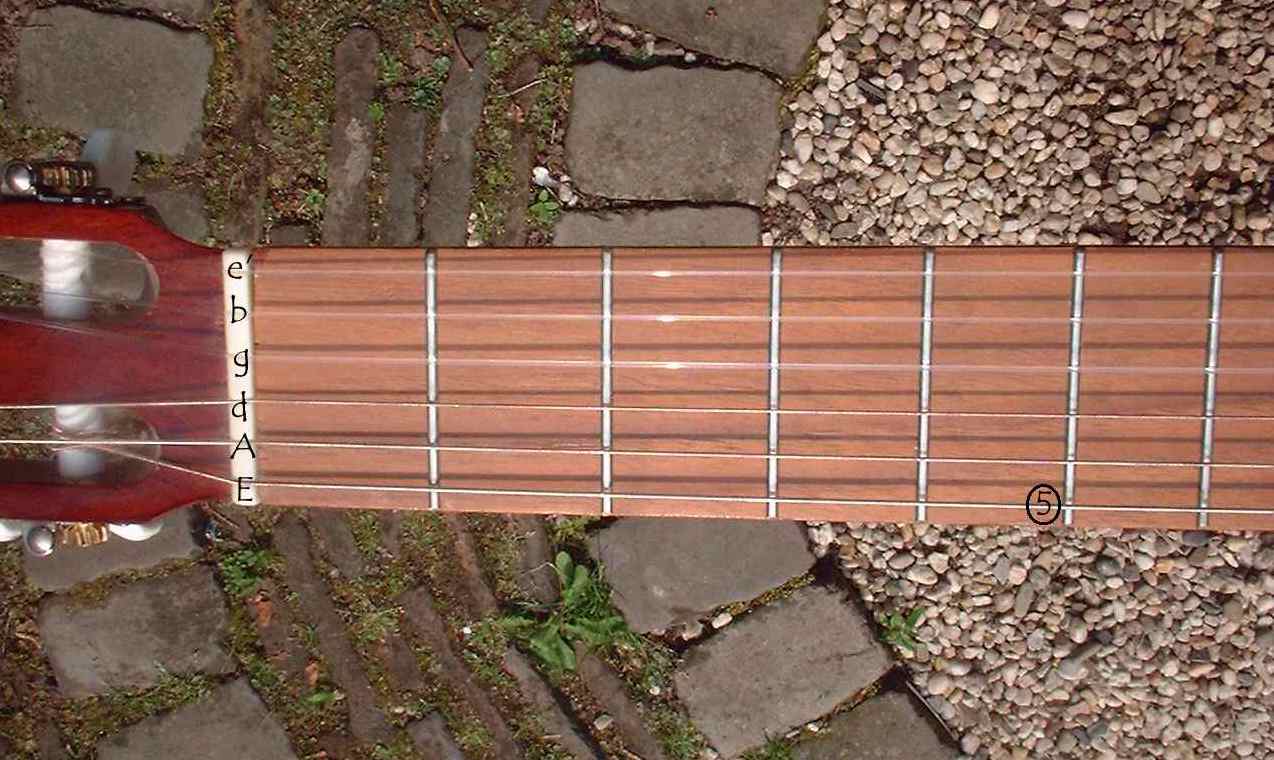 5th fret,
and tune
the E string until at that 5th fret it has the
same pitch as the open A string.
5th fret,
and tune
the E string until at that 5th fret it has the
same pitch as the open A string.
- Press the A string at the 5th fret, and tune the open d string until it has the same pitch as the A string at that 5th fret.
- Press the d string at the 5th fret, and tune the open g string until it has the same pitch as the d string at that 5th fret.
- Press the g string at the
 4th fret
(really 4th here, this is not a typo),
fret, and tune
the open b string until it has the same pitch as the
g string at that 4th fret.
4th fret
(really 4th here, this is not a typo),
fret, and tune
the open b string until it has the same pitch as the
g string at that 4th fret.
- Press the b string at the 5th fret, and tune the open e′ string until it has the same pitch as the b string at that 5th fret.
If you are using new strings, you’ll have to repeat this procedure several times, and include pauses of several minutes, if not hours. The strings need time to get used to their new tensioned existence.
If after this procedure, the guitar is roughly in tune, and stays that way, is stable, you can continue with the fine-tuning.
Finding the 110 Hz A on the piano
The
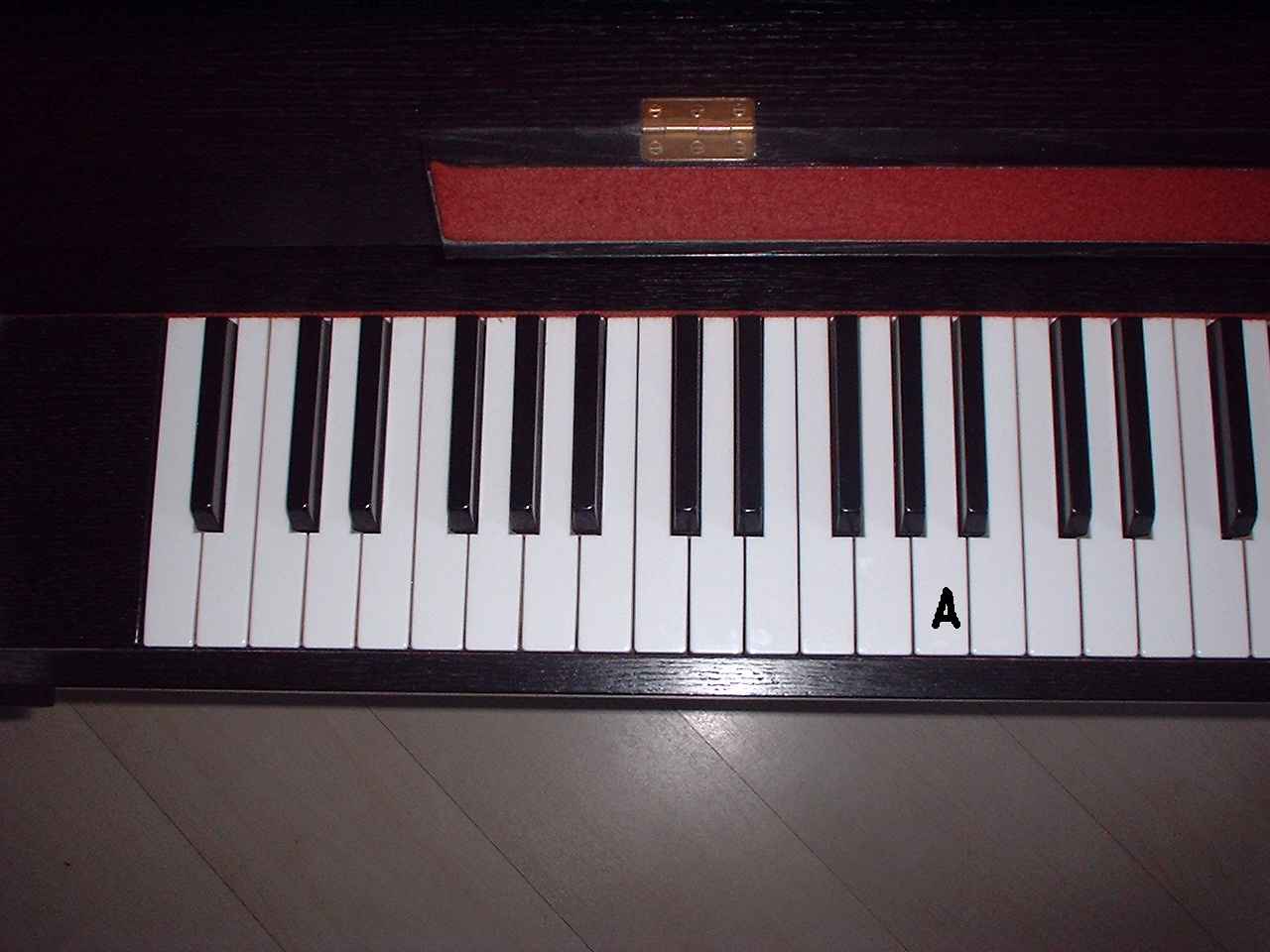 110 Hz A that corresponds to the 5th guitar string is the
15th white key of the piano, counting from the left.
110 Hz A that corresponds to the 5th guitar string is the
15th white key of the piano, counting from the left.
If you learnt to play the piano and to read music, don’t be confused by the fact that the note used for the open guitar string A is the 22nd white key on the piano: that’s because a guitar sounds an octave lower than it’s written.
Push down the
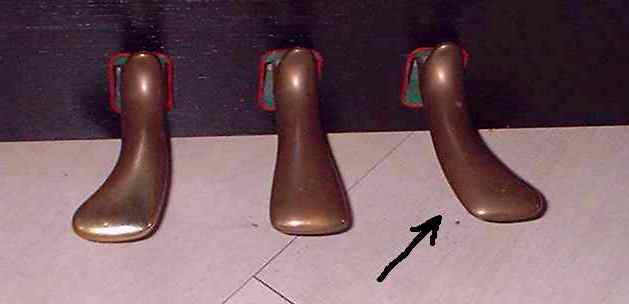 right pedal
(the damper pedal) of the piano with your foot,
and keep it depressed, so you keep hearing the note while using
your hands to hold and play the guitar.
right pedal
(the damper pedal) of the piano with your foot,
and keep it depressed, so you keep hearing the note while using
your hands to hold and play the guitar.
Details of background
Even temperament
Ideally, the two notes of an interval, of the three or more notes of a chord, should have frequencies that can be expressed as the ratio of small integers. That is because the notes then have overtones that are equal or very close to each other.
Yet, tuning systems based on that principle cannot be used equally well in all keys. To solve that problem, the even temperament (sometimes called equal temperament) was invented. The ratio between each pair of subsequent semitones is exactly the same then, but chords and intervals are not exactly right. It is a good compromise though. This Java applet demonstrates very clearly that such a solution is really needed.
The frets of a guitar are probably placed based on even temperament. If the strings are also tuned according to that, everything should be OK. This can be achieved by tuning to a well-tuned piano (now using 6 notes), or by using an electronic tuning device. Yet, results are not always optimal. Because guitar music is often in one of a small number of keys, and some chords are used more often than others, it is probably advantageous not to use the even temperament, but a tuning that fits better to guitars and guitar music instead.
Extra string tension when pressing string against fret.
A string must be bent a little in order to press it against a fret. Bending a strings increases the tension, and so makes the sound higher. How strong this effect is depends on two factors:
The height of the bridge. On some guitars, this is adjustable.
The ratio of the string’s length in tensioned condition (when on the guitar), and the untensioned length (before you put it on). With metal strings, this ratio is much smaller than with nylon strings. This is the reason why vibrato is much easier to make with metal strings.
Jimi Hendrix
The ratio also increases with string thickness, and so with string tension: a thinner string sounds higher by nature, so needs less extra tension to reach a predefined pitch.Of course the guitar builder takes this effect into account when determining the correct placement of the frets. But there is no telling what strings the player is going to use, so this is always a compromise.
Overtones are not exact multiples, and need not be.
A Vibrating string produces its lowest frequency by having an antinode
 (= point with strongest vibration) in the middle, and the
nodes
(= point with no vibration) at either end.
(= point with strongest vibration) in the middle, and the
nodes
(= point with no vibration) at either end.
(In Dutch, we call antinodes ‘buik’, which means ‘belly’. Isn’t that a much nicer word?).But at the same time, it vibrates with antinodes at 1/4 and 3/4 of string length, and an extra node in the middle. The frequency of that vibration is twice that of the lowest frequency.
Likewise there is a third harmonic (overtone), with antinodes at 1/6, 3/6 and 5/6, and nodes at 0, 2/6, 4/6 and 6/6. The list goes on until maybe the 18th harmonic or even higher.Normally, all these overtones sound together at the same time, some strengthened, some weakened, due to the acoustic properties of the guitar case. This mixtures of frequencies constitutes the timbre.
You can make a particular group of overtones sound separately, by damping other ones. Damping is done by slightly touching the string at a certain position, while picking it at another. Such a technique produces the so-called flageolets or harmonics.
For example, when damping a string at half its length, which is an antinode for the base note, and for the third, fifth, seventh etc. harmonic, but a node for the 2nd, 4th, 6th etc. harmonic, you can produce a sound that consists only of even harmonics. So this is in fact a note in its own right, with a frequency twice as high, in other words, an octave higher.
By doing the same at 1/3 or 2/3 of the length, you produce a note three times as high, which means it is an octave and a third higher.
Damping at 1/4 or 3/4 of the length, you produce a note four times as high, or two octaves higher.
Etc. etc.This is where tuning comes into play: 1/3 of open string length is over the 7th guitar fret, 1/4 of string length is over the 5th fret. The 4th harmonic of a string - say the A string - has the same pitch as the 3rd harmonic of the next higher string d: both are a′, with a frequency of 440 Hz.
So playing these together, and adjusting the d string so the harmonics have exactly equal pitch, could be a way of tuning a guitar. But in practice, this method produces disappointing results, for two reasons:
Overtones have frequencies that are exact integer multiples of the base frequency only in theory. In reality, the ratio is usually not an exact integer, although it is close to that. This has to do with string quality, age and wear, but to a certain extent, it is also a desirable effect: it makes a long sustained note slowly vary over time, so it sounds warm and lively, not cold and mechanical. As a result of this property of string harmonics, you can see and hear a low string (say, open E) slowly change its vibration pattern.
This is also why 1970s synthesizers, when sample-based tone-generation was not yet technically feasible (unless at very high prices, e.g. Fairlight) did not sound very good.
As a result, using string harmonics to tune a guitar introduces small errors.When using the harmonics of adjacent strings, you use a previously tuned string as a reference for each next string, instead of using the same string as a reference all the time. This means errors accumulate, and the result is that the guitar ends up out-of-tune.
In the method I recommend on the other hand, the same strings A is the reference in nearly all comparisons, so errors do not add up, and the overall result is much better.
Note that in my method I use fifth comparisons to tune A and E, A and e. In fact, such a comparison also involves overtones, because in a fifth, the third harmonic of the lower note has the same pitch as the second harmonic of the higher note. If they are not exactly equal, that is what’s causing the slow (or worse, fast) beat note you hear when playing these notes together.
Yet, the result of tuning the A and d strings in this way (using 3rd and 2nd harmonics), and tuning them directly by flageolets (using 4th and 3rd harmonics), doesn’t always produce the same result, although it often does. Same with the E and A strings.
More notes
Thin, low-tension metal strings are easiest for creating vibrato effects, either with the fingers, or on some electric guitars, using a special handle. Jimi Hendrix often tuned his guitar one semitone lower than normal, so the E string was E-flat. This may have been a habit origination from the early days of his career as a guitartist, when he often played in bands which also had wind instruments. They are easier to play in keys like E-flat, B-flat; on a normally tuned guitar, though, chords to such keys are difficult and more tiring.
But it may also be he did it to make vibrato, and glissandi in the same fret position, pushing the string up, which he used a lot, even easier. This is because tuning a guitar to a lower pitch decreases the ratio tensioned-untensioned, which means extra tension has a relatively greater influence, and results in more pitch bend.
Apart from the normal guitar tuning,
 E-A-d-g-b-e′, several other
tunings are possible. This is called scordatura (Italian for de-tuning). Some
people are very good at it, they seem to be using a different tuning for almost
every piece. It can have a refreshing effect, and open unexpected musical ventures.
An example is Joni Mitchell.
E-A-d-g-b-e′, several other
tunings are possible. This is called scordatura (Italian for de-tuning). Some
people are very good at it, they seem to be using a different tuning for almost
every piece. It can have a refreshing effect, and open unexpected musical ventures.
An example is Joni Mitchell.
So far, I haven’t used much theory to find a tuning method, but rather
I followed my experience of what I found led to reasonable results.
Nevertheless it is
interesting to apply some tuning theory and
mathematics in hindsight, to see what frequencies and intervals
the tuning method results in, and to try to explain why it sounds
as good as it does.
I devoted a separate page to that.
Copyright © 2001, 2003, 2008 R. Harmsen